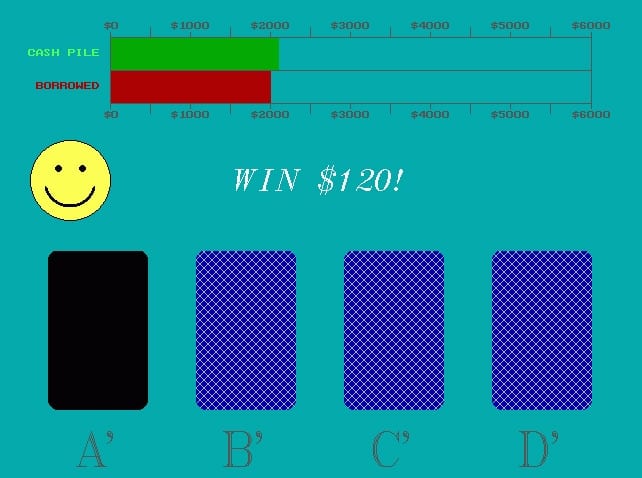The story of Archie Karas is true, but it reads like a legend. With only $50 in his pocket, and a gambling spree in Las Vegas, he made himself a multimillionaire in a matter of weeks. Almost just as quickly, he lost it all. He joins a long list of gamblers who have defied the odds, but only for a while. The trope of a gambler pushing their luck too far is something we’re all familiar with.
Now classified as an addiction, problem gambling has been recognized by the DSM-V as a disorder akin to substance abuse. One of the hallmarks (maybe the hallmark) of an unhealthy gambling approach is the failure to objectively evaluate the odds they are faced with. And one of the ways this can be tested is with the Iowa Gambling Task.
First designed by Antoine Bechara and others in 1994, the test was originally used to measure decision-making abilities. This decision-making required that the participants simply select a card from one of four decks – hardly a tricky bet. Unlike casinos however, the cards really are stacked in your favor – or against them.
Two of the decks that can be selected will reliably provide a profit in the long-term. They don’t give big wins, but the losses (or “punishments”) are smaller, and you’ll come out on top if you stick to them. The other two decks however provide huge profits, but also huge losses, and over enough trials will leave you bankrupt. Of course, this information isn’t revealed to the participant – just that they should win as much money as possible.

While the participants complete the test, they have some information available to them – how their earnings (or losses) are looking. The decks never change in their likelihoods of delivering a profit or loss, so eventually the average person figures this out, and sticks to a strategy. They consistently select the decks that deliver profit over the long-term.
Luck of the Draw
For some people however – problem gamblers in particular – the thrill of the bigger win is too much of a pull, and they will continue to select the “bad” decks even as the losses pile up. It’s not only problem gamblers who struggle to see clearly when presented with this task however. The very first study that utilized the test recruited individuals with prefrontal cortex damage as participants, finding that they too were susceptible to losses in the long run.
As the original study demonstrated, one of the frequent outcomes from prefrontal cortex damage is the worsening of decision-making capabilities. Our ability to think clearly is maintained through executive function – not a soirée for business professionals, but a set of cognitive processes that control how we act in day-to-day life. When we steer clear of risky situations, or exert control over ourselves in some way, we are using our executive function to keep ourselves in line.
Damage to the prefrontal cortex often leads to a worsening of this executive function, and individuals can become pleasure-seeking and hedonistic – less able to plan for the future, more keen to live in the present.
Dr. Harlow and Mr. Gage
On a summer’s day in Vermont, in 1848, a young Dr. Williams was politely informed that there was someone in need of his assistance, and soon found the patient vomiting out part of his own brain. This was – mercifully – not an ordinary case.
The patient in question – Phineas Gage – had just been struck through his head by a narrow iron pole. This was usually used to help plant explosives, clearing the way for a future railroad, but now lay covered in blood and gore. The explosion had happened unexpectedly, firing the metal bar up through his prefrontal cortex, leaving a hole clear through.

There were at least two unusual occurrences with this case. The first was that Mr. Gage survived, the second is that he was studied so well. Dr. Harlow, who took over with the care of Phineas, was a fastidious physician, ensuring that the story of Phineas Gage would be extensive enough to study for decades to come (as it has been).
In particular, Harlow was able to document how Gage’s behavior changed following the injury – how he went from a calm and stoic man, to one ruled by capricious emotions. This case would ultimately help our understanding of how the prefrontal cortices function, and how they can rein in the more risk-prone parts of our personalities. It would be a safe bet that he would not make safe bets on the Iowa Gambling Task.
Executive Suite of Responses
As is apparent from the story of Phineas Gage (and many more tragic tales since), our executive function is critical for normal behavior. This underlines the importance of tests like the Iowa Gambling Task, and the Stroop Task, both of which measure how well our implicit executive function performs.
More recent experiments have also taken our understanding of this further, using psychophysiological measurements to delve deeper. Using measurements of electrodermal activity (EDA) / galvanic skin response (GSR), Bechara (of the original Iowa Gambling Task study) and others, found that control participants would show an increased skin conductance response when considering a risky choice (as compared to participants with prefrontal cortex damage), even before they were consciously aware that it was a risky choice they were considering.
Further to this, Anna Goudriaan and others measured both GSR and heart rate, finding that pathological gamblers exhibited a lower psychophysiological response to the disadvantageous decks than control participants, suggesting that they were less implicitly aware of the threat. Both the GSR and heart rate measurements helped provide a broader picture of the participant’s physiology during the task.

Another study by Scott Oberg and others used EEG, showing that self-identified gamblers exhibit abnormal neural responses to gambling feedback. Responses to reward typically consist of several standard outcomes related to feedback, which are found to be distorted (both sensitized and blunted) in the gambling population. This shows that the physiological response can even be tracked at the neural level.
Feeling Lucky
A central theory that has arisen due to the findings of the Iowa Gambling Task, is that of the somatic marker hypothesis (originally put forward by Antonio Damasio, who was also an author in the original Iowa Gambling Task article). This theory states that somatic markers – markers of our bodily functioning, such as a raised heartbeat indicating anxiety – ultimately rule our decision making capabilities.
These somatic markers can be measured using psychophysiological measurements, making the entry into investigating how our emotions might change our decision making an accessible process.
Although the somatic marker hypothesis is not without criticism, recent studies using the Iowa Gambling Task have provided evidence that emotions can change our decision making capabilities. For example, Eldad Yechiam and others showed that unhappiness can increase avoidance of a task that is deemed to bring about frequent losses, as compared to other happy participants.
Hit the Jackpot
There are a variety of studies that show the value in investigating psychophysiological responses to the Iowa Gambling Task, all of which have consequences for how we interpret the decision making process. Should we believe that emotions rule above all, or are we entirely logical? Most likely the answer is somewhere in between. What is clear is that we’ll need to use simultaneous and complementary measurements of human physiology in order to understand how exactly our decisions are made.
By utilizing measurements of GSR or heart rate (through electrocardiography – ECG), we can discern the level of physiological arousal that a person is experiencing, which can be related to their emotions. These emotions can be manipulated beforehand or even measured using facial expression analysis. All of these measurements can also be used alongside EEG to provide an understanding of the participant’s responses to reward feedback within the Iowa Gambling Task.

Combining all of these measurements can be an onerous task, and for a relatively short test such as the Iowa Gambling Task, it can take longer to set up each participant than it does for them to complete the experiment. Using iMotions as all-in-one platform for each of these measurements improves both the speed and ease of setup, which ultimately means that the answers to these research questions can be reached faster.
Having access to the right tools makes any job easier, and more likely to yield the desired results. By using iMotions alongside the Iowa Gambling Task, it’s much simpler to explore the varied psychophysiological responses of decision making, and to evaluate them in relation to each other. The choice of each of these can be expanded or modified according to the study requirements, and the questions being asked.
Conclusion
Throughout our lives we will always be faced with decisions to make. How these decisions are decided will be controlled by our executive function. This, in turn, is likely mediated by our emotions at a given point in time. It therefore follows that if we are to understand our behavior as humans, we will need to both study our decisions, our self-control (executive function), and our emotions. By approaching these questions with multiple psychophysiological measurements, synchronized by iMotions, and the Iowa Gambling Task, we can start to dissect what’s really behind our decisions.
I hope you’ve enjoyed reading about the Iowa Gambling Task, and how it can be used alongside other measures to investigate decision-making and executive function. If you’d like to learn more about one of the ways in which investigations can be made of the underlying neural processes, then download our free EEG pocket guide below, and let us know how you’d use the Iowa Gambling Task.












